 1940-41 Lincoln Continental - Stars Of The Lincoln Show
1940-41 Lincoln Continental - Stars Of The Lincoln Show
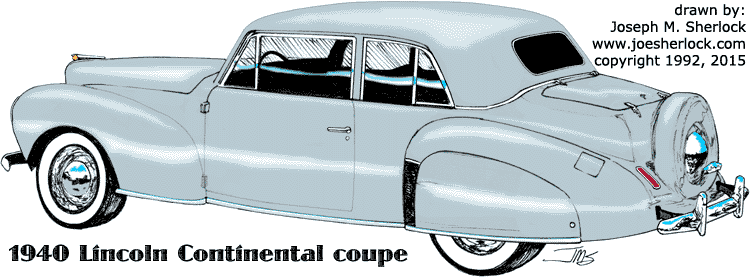
If you're into the 'What If' game, you can spend hours imagining what the Ford Motor Company would have been like if Edsel B. Ford had run the show. What if Henry had been pushed aside to work on his crazy ideas like the soybean car and special farmer-oriented vehicles?
Edsel was known as a listener and a delegator - a good manager. It would be easy to envision an Engineering Department under Edsel, ditching those transverse front leaf springs in favor of a real front suspension, equipping all cars with hydraulic brakes, fixing the vapor lock problems on the Ford V8 and the durability problems on the Zephyr V12. Ford might have become the King of Vehicles, setting the world standard - or at least the American standard - in all things automotive.
But, alas, it was not to be. Shackled by the increasing lunacy and unpredictability of his father Henry, whose emerging dementia had him on the trolley line to Crazyville, Edsel sought refuge in style while his dad ranted about the Jewish banking conspiracy and tried to run FoMoCo into the ground with his agrarian-focused, semi-addled brain.
Style was something with which Edsel was comfortable; he had a lifelong passion for art. He and his wife were patrons of the arts and Edsel, while having no formal design training, had a good eye for things. You don't have to be an expert on grape stomping to appreciate a good wine.
Edsel ran Lincoln ever since Henry bought it for him in 1921. Edsel had worked with coachbuilders to make the stodgy L-series more attractive. In the 30s, he relentlessly pursued obtaining stylish coachwork for the handsome K-Series Lincolns.
In 1935, Edsel established the Ford Design Department and picked E. T. 'Bob' Gregorie, a former yacht designer and employee of coachbuilder Brewster Body Co. - a talented man that Edsel had hired a few years before, to head it. Gregorie, under Edsel's direction, put the final successful styling touches on the Zephyr (the car that saved Lincoln) and oversaw the design of the brand-new Mercury line. And, of course, the first Lincoln Continental.
In the fall of 1938, Edsel Ford returned from a trip to Europe. He was impressed by the look of European sports models - the long hoods, short rear decks and rear-mounted spare tires. Edsel approached Bob Gregorie and asked him to create a custom car with a 'Continental' look. A new kind of car was soon to emerge from Ford Motor Company.
Edsel wanted a one-off prototype to show off during his March 1939 vacation to Hobe Sound, Florida - a winter gathering spot for the wealthy, located between Florida's Gold Coast and Treasure Coast. Gregorie penned a sectioned and channeled low-slung Zephyr convertible with the requisite long hood and spare tire on the back, had it built and shipped it to Florida. The car was elegant, painted in a conservative Eagle Gray color.
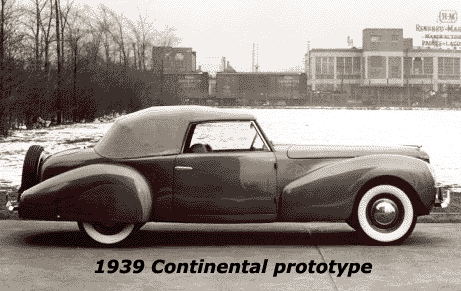
Edsel called Bob from Florida, relating that his new car had received "rave reviews" from everyone who laid eyes on it. Edsel stated that he "could have sold a thousand of them" and ordered Gregorie to put the car into production.
So, on September 20, 1939, the new 1940 Lincoln Continental was introduced to the world. Available initially only as a Cabriolet, a Coupe version was introduced later in the year. First-year sales were modest: 350 drop-tops and 40 coupes. In 1941, 400 Cabriolets were produced along with 850 coupes. 1940 and '41 models are almost identical in appearance. The most distinctive difference is that the 1941 models have parking lights atop the front fenders.
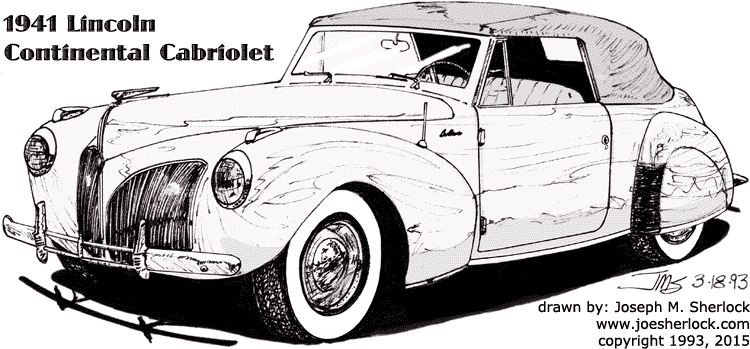
Engine, transmission and other mechanical components were shared with the Lincoln Zephyr. The 292 horsepower V12 engine produced 120 horsepower. Considering that the Continental weighed almost 4,000 pounds, it was no hot rod. Nor was it designed to be. The Continental was to be a gorgeous boulevard cruiser and it performed that task very well.
Celebrities embraced the handsome new car. Rita Hayworth, Jackie Cooper, Mickey Rooney, Clark Gable, John Wayne, boxer Joe Louis and Jack Benny - purchased sleek, new Lincoln Continentals.
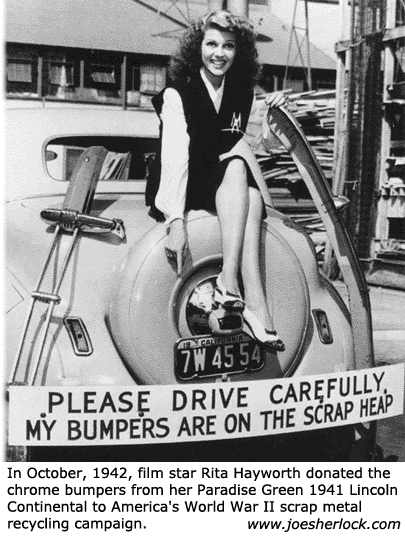
There wasn't anything to compare with the Lincoln Continental. Yes, Packard had its Darrin but, at an extremely high price of $4,570, only about 40 Victorias were produced in 1940. In comparison, the 1940 Lincoln Continental was priced at $2,840 and over 400 examples were sold. As production ramped up, 1,250 Continentals were sold in 1941. As for the Packard Darrin, production was moved to the Sayers & Scoville hearse plant in Ohio for the 1941 model year, where only 35 '41 Packard Darrin Victorias were produced.
While the Continental wasn't a big seller in itself, it undoubtedly brought attention to the rest of the Lincoln Zephyr line and traffic to the showroom. It is possible that the Lincoln Continental was the first 'halo car'.
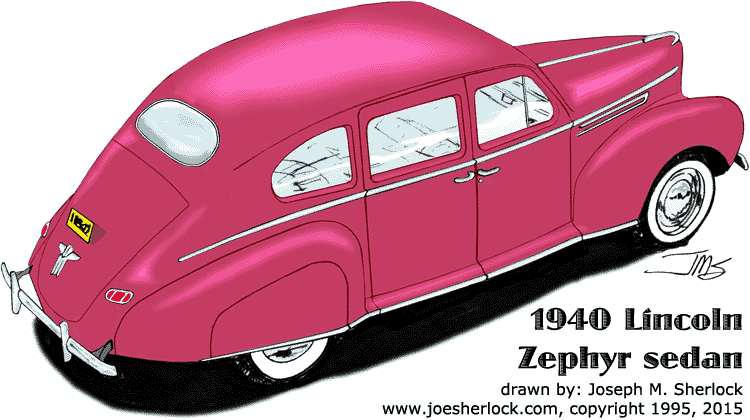
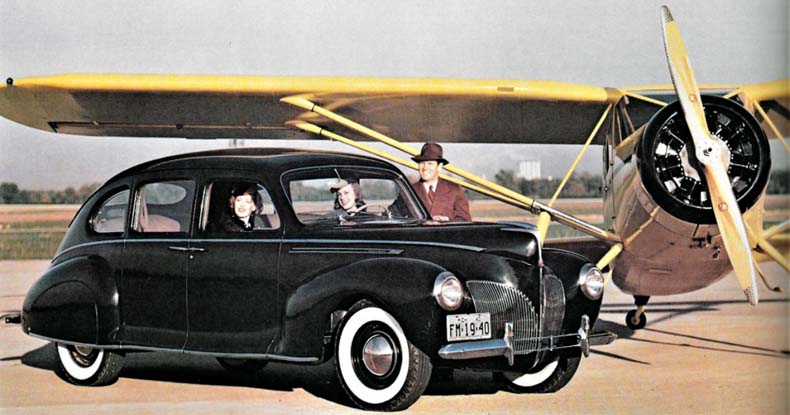
Continental production figures were dwarfed by those of its larger brother, the Zephyr. The restyled, handsome in its own right 1940 Zephyr sold 21,514 vehicles that year, 15,764 were four-door sedans. In 1941, 20,744 Zephyrs found buyers, 14,469 were four-door sedans, priced at a reasonable $1,541. In the race to sanctify the beloved Continental, the Zephyr is often given short shrift. It's important to remember that, without the Zephyr, there never could have been a Continental. But make no mistake: the Continental was the star of the Lincoln show.
Edsel lived to see his Continental dream come true. But the war caused production of all cars to cease in early 1942, and Ford and other auto manufacturers began producing jeeps, tanks and other war material.
Unfortunately, Edsel B. Ford's fragile health failed; he died of stomach cancer in 1943. Without a mentor and champion, Bob Gregorie soon left Ford. He was later convinced to return by Edsel's son Henry II, when the second HF deposed his grandfather Henry I. But Gregorie soon tired of the new formalized management structure at the company and left Ford for good.
|
|
|
Pre-war Lincoln Continentals at Pebble Beach - 1996
|
Gregorie moved to Florida and never designed another automobile. Instead, he penned custom yachts for the wealthy. Things had come full circle for Bob. (4/30/16)
|
Cars In Scale
|
|
|
| This 1:25 scale pewter-colored model was produced by Banthrico.
In the late 1940s, Banthrico, a Chicago firm which made hand-cast metal promotional items, began producing banks in the shape of automobiles. These bottom-slotted, 1:25 scale coin-banks were sometimes also painted in authentic factory colors and used as "paint chips" by car dealers.
These low-pressure cast vehicles were fairly basic, lacking see-through windows or interiors. Banthrico was sold to Minnesota-based Toystalgia - once a maker of wooden banks (now out of business) - in 1985, although most buyers still referred to the white-metal models as Banthricos.
|
|
|
| These seven models represent some of the 1941 Lincoln Continentals produced by toy and model firms.
In front, is a Cragstan plastic model with friction motor. This model measures 1:49 scale and is tan with a burgundy top. Long out of production, this toy cost less than a dollar when produced in the late 1960s. The all-chrome spare tire is a charming touch.
Left to Right: The diecast gray top-down Cabriolet and its top-up dark blue brother were made by Rio in Italy during the 1970s and '80s. The green top-down 1941 Lincoln Continental is 1:43 scale in length but is almost 10% too wide. Made by Ixo Models (in China) in 2008, it was mistakenly identified as a 1939 model. The maroon top-down 1:43 model was produced by Eagle Collectibles in 2003 and was well-made for a low-priced diecast. The metallic gray Continental was diecast by the German firm, Minichamps (but made in China), for Ford Motor Company's 100th anniversary in 2003. It was sold as part of a set along with several other iconic Ford and Mercury models.
|
|
Remember When: 1940 & 1941
|
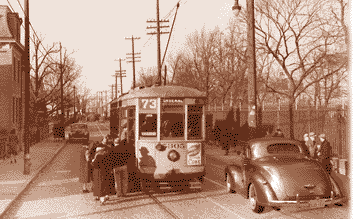 In 1940, the Great Depression was beginning to ease; Americans were earning more and buying more so being able to buy goods and further fueling the economy. Germany invaded France, Denmark, Luxembourg Belgium, Netherlands and Norway. Germany and Italy agreed to form an alliance against France and the United Kingdom. Bombs fell on Great Britain. In 1940, the Great Depression was beginning to ease; Americans were earning more and buying more so being able to buy goods and further fueling the economy. Germany invaded France, Denmark, Luxembourg Belgium, Netherlands and Norway. Germany and Italy agreed to form an alliance against France and the United Kingdom. Bombs fell on Great Britain.
In the 1940 Presidential Election, Franklin D. Roosevelt defeated Republican Wendell Willkie and gained an unprecedented third term. The Selective Training and Service Act was signed into law as first peacetime military draft in United States history.
In 1940, a new house cost $3,920; the average income per year was $1,725. The price of a gallon of gas was 11¢.
The 28 millionth Ford, a 1940 Fordor sedan, appeared at the New York World's Fair as part of its 'International Good Will Tour'.
Synthetic rubber was the most important of several new products debuting in 1940; fads included calypso music, and roller rink skating.
Popular films included 'Pinocchio', 'Fantasia', 'The Grapes of Wrath', 'My Little Chickadee' and 'The Great Dictator', starring Charlie Chaplin.
1940 produced several memorable hit songs: 'I'll Never Smile Again' by Tommy Dorsey with Frank Sinatra, Glenn Miller's 'In the Mood' and 'Pennsylvania 6-5000' as well as Artie Shaw's 'Frenesi'.
Several famous people were born in 1940: Mario Andretti, Tom Brokaw, Herbie Hancock, John Lennon, Ringo Starr, golfer Jack Nicklaus and singer Tina Turner.
Deaths included Walter P. Chrysler, Leon Trotsky, Austrian auto/airplane builder Edmund Rumpler, Neville Chamberlain, writer F. Scott Fitzgerald and movie cowboy Tom Mix, who died behind the wheel of his supercharged '37 Cord 812 convertible near Florence, Arizona (southeast of Phoenix). A flagman had stopped him and warned about roadwork in progress to repair a washed-out bridge. Ignoring the flagman, Mix drove on and plunged into a ravine; the convertible flipped, resulting in instant death. The gully has since been renamed Tom Mix Wash.
In baseball, the Cincinnati Reds defeated the Detroit Tigers to win the 1940 World Series.
In 1941, the carving of Mount Rushmore was completed. The fourth Thursday in November was officially designated as Thanksgiving Day. Germany defeated Greece and Yugoslavia. Soon, it invaded the USSR. Nazi aircraft sunk a Russian hospital ship killing 7,000. The British sunk the German battleship, the Bismark. FDR was sworn in for his third term as U.S. president.
The U.S. began to prepare for war; rationing was initiated and the first Liberty Ship was launched. Roosevelt signed the Lend Lease Act, providing military aid to the Allies. The first tank rolled off Chrysler's Army Tank Arsenal production line on April 24th. Winston Churchill addressed a joint meeting of the United States Congress about the War in Europe. Germany and Italy declared war on the U.S. In December, the Japanese attacked Pearl Harbor.
In Germany, Konrad Zuse developed the Z3 - the world's first electronic, fully programmable digital computer based on a binary floating-point number and switching system. The Z3 computer was the first machine to be controlled by software. Plutonium was discovered at U.C. Berkeley.
By the '41 model year, running boards on U.S. passenger cars had mostly disappeared. The 4 millionth Plymouth was delivered to a dealer and the 29 millionth Ford was produced. In 1941, the five-millionth Dodge was built - a four-door sedan.
Henry Ford dramatically unveiled his soybean-based experimental plastic to the public by attacking the plastic trunk of a Ford with an axe. Chrysler commenced production of the luxurious Town & Country woody wagon. Buick offered the first four-barrel carburetor - actually a compound carb set-up - on its Fireball straight-eight engine. Hydra-Matic Drive was now offered on both Cadillacs and Buicks. It soon would be used in tanks.
Chrysler introduced two dream cars, the two-seat, retractable hardtop Thunderbolt and the Newport Parade Phaeton. One of the Newports was the pace car at the 1941 Indianapolis 500. Los Angeles got its first freeway, connecting LA & Pasadena.
The Union Pacific Big Boy, the largest steam locomotive in the world, entered freight service in 1941. The 4-8-8-4 articulated loco and tender were almost 133 feet in length, weighed 762,000 pounds and produced 6,290 horsepower.
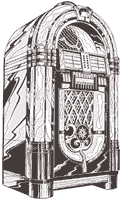 Big record hits - sold in the form of large, 10-inch diameter, mineral-filled shellac 78 rpm recorded discs - included 'Duke Ellington's Take the A Train, 'Frenesi' by Artie Shaw and his orchestra, The Andrews Sisters' 'Boogie Woogie Bugle Boy' and 'Racing with the Moon' by Vaughn Monroe. Big record hits - sold in the form of large, 10-inch diameter, mineral-filled shellac 78 rpm recorded discs - included 'Duke Ellington's Take the A Train, 'Frenesi' by Artie Shaw and his orchestra, The Andrews Sisters' 'Boogie Woogie Bugle Boy' and 'Racing with the Moon' by Vaughn Monroe.
There were several notable 1941 movies: 'Citizen Kane', 'Dumbo', 'How Green Was my Valley', W.C. Fields' 'Never Give A Sucker An Even Break' and 'The Maltese Falcon'. Bugs Bunny made his silver screen debut in 'A Wild Hare.' The first commercial television license was granted a NYC station in '41.
According to Life magazine, 1941 fads included campus blanket parties and floppy hats. In horse racing, Whirlaway won the Triple Crown.
Quite a few famous folks were born in '41: Paul Anka, Joan Baez, Bob Dylan, Wilson Pickett, Pete Rose and journalist George Will.
Deaths included novelist James Joyce, auto pioneer Louis Chevrolet, King Alfonso XIII of Spain, French tire magnate Andre Michelin, NY Yankee Lou Gehrig and jazz pianist Jelly Roll Morton.
In sports, Joe DiMaggio achieved a 56 consecutive game hitting streak. The New York Yankees beat the Brooklyn Dodgers, winning the World Series in five games.
|
More AutoSketch car drawings can be found here.
Other Pages Of Interest
| blog: 'The View Through The Windshield' |
| essays: greatest hits | blog archives | '39 Plymouth | model train layout |
| about me | about the blog | e-mail |
copyright 2015-20 - Joseph M. Sherlock - All applicable rights reserved. Drawings copyright 1992,1993, 1995, 2015
Disclaimer
The facts presented on this website are based on my best guesses and my substantially faulty geezer memory. The opinions expressed herein are strictly those of the author and are protected by the U.S. Constitution. Probably.
Spelling, punctuation and syntax errors are cheerfully repaired when I find them; grudgingly fixed when you do.
If I have slandered any brands of automobiles, either expressly or inadvertently, they're most likely crap cars and deserve it. Automobile manufacturers should be aware that they always have the option of trying to change my mind by providing me with vehicles to test drive.
If I have slandered any people or corporations, either expressly or inadvertently, they should buy me strong drinks (and an expensive meal) and try to prove to me that they're not the jerks I've portrayed them to be. If you're buying, I'm willing to listen.
Don't be shy - try a bribe. It might help.
|
|